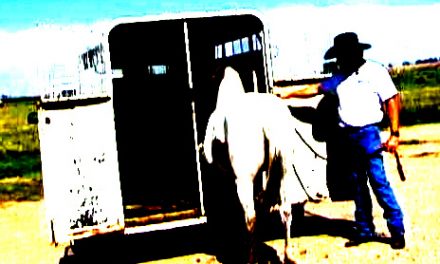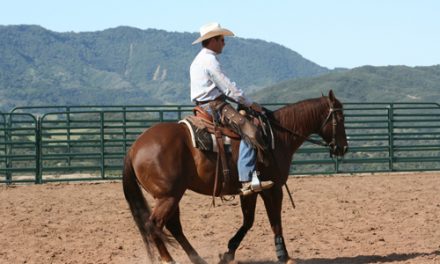 Every time I get on a horse there are always six areas that I work on. This is true for both a horse that has just come in for training and for a finished horse. Every time I get on I work on these specific areas and I have noticed that these are the areas where riders have the most questions and problems.
Every time I get on a horse there are always six areas that I work on. This is true for both a horse that has just come in for training and for a finished horse. Every time I get on I work on these specific areas and I have noticed that these are the areas where riders have the most questions and problems.
When I am training a horse, the first thing I do is make sure the horse will go forward. Many of the horses I get on don’t want to go forward and this is one of the problem areas I work on a lot. A horse that does not want to go forward is what we call behind the leg. When a horse lags and there is no impulsion or energy coming from behind, the hips and hocks are not engaged and the horse is pulling himself along with his front legs. I want the horse to move out at my cue and to come up under himself from behind. So, at the same time that I am getting the horse forward, I work on establishing a solid forward cue. Some riders are not consistent in the way they cue the horse and the horse becomes confused. They get the horse forward and then they let the horse lag or suck back and then they nag at the horse to pick up the pace again. The horse never learns the cue that soft pressure from the leg consistently means go forward.
Another major problem with some horses is that they do not stop. I have found that the stop and the back up go hand in hand. If I have a good stop, I will usually have a relatively good back up so I categorize these issues together. The second and third areas then are the stop and the back up. I say whoa, I ask with my seat and the reins are always the last aid that I use to motivate a change from forward to stop. Most of the horses that come here do not have a good stop and this is true of both western and English horses. Of course there are exceptions. I have had some reining cow horses come in who have some awesome stops because that is how they were trained. You say the word whoa and they are ripping ground and sliding. Most of the horses that come here haven’t had that type of training and they do what we call, run through your hands. The horse pulls the reins through the rider’s hands and falls down on the front end. When you pick up the reins and ask the horse to back with your seat and legs, the head goes up and the back hollows out. If the owner keeps pulling the horse may even rear up.
The fourth area I work on is shoulder control as this is another area that always seems to need work. Of course, we must have control of the nose and we want the nose to be soft and responsive but what riders often don’t realize is that it is the shoulders that are steering the horse, not the nose. When you want to establish a nice circle, it is the shoulders that will guide you on that circle. It is very natural for a horse to want to bleed out through the shoulder, in other words travel to the outside of the circle instead of staying on the circle. Riding a circle, the other thing that happens is the horse drops the inside shoulder and it falls in toward the center of the circle.
Few people work on shoulder control. I have seen dropped shoulders in all disciplines because the rider is not using the leg and rein aids to keep the horse upright. Lack of shoulder control is caused by improper use of the outside rein. Most people do not know how to use the outside rein. Using the outside or supporting rein you can stop the outside shoulder from bleeding out. Using the outside rein properly keeps the horse between the reins.
The fifth area I work on is getting the horse to respond to proper rein aid cues. Proper use of the rein aids is a subject all by itself. Most people ride with either too long or too short a rein. The rider is either in the horse’s mouth or has no contact. Most riders are taught to ride with a light rein so many let the horse pull on the reins. We want to be light with the reins but we must teach the horse to respond to a light rein. When a horse is being taught to respond to the rein, we ask with a light rein and if the horse does not respond we hold, then vibrate the rein until the horse yields, then we release the pressure. You must learn not to release the pressure when the horse is pulling or bracing on the bit. There are also exercises that teach the horse to yield to the reins. The horse must respect your hands. You can’t do anything with a horse that is bracing against the reins and pulling on you. When a horse does that, he is totally on the forehand and you have no control.
The sixth major area I work on is hip control. Hip control is the easiest thing to teach and I know that everyone wants to do the one rein stop when the horse is moving too fast. Until about fifteen years ago I was a proponent of this maneuver where you pull the nose around, move the hips over and stop. What I found with this maneuver however, is that even though the horse stops it is still excited, still abrasive and unresponsive. I think it is better to keep the horse moving the hips around until it becomes responsive and soft or yielding to my hands.
By moving the hips to engage for collection so that we can pick up the correct lead, we sometimes over bend the horse. We want the neck of the horse to be straight or relatively straight. For example, when I am riding a twenty-meter circle and I pick up the inside rein, if I see more than the corner of the horse’s eye, I have too much bend. Everyone wants to use too much inside rein which goes back to shoulder control. It is natural to pull on the inside rein, we think this is going to make the horse turn quicker and all the while it is going sideways and blowing out the shoulder. In reality it is the outside leg and rein that will make the horse turn and stay on the circle.
These are the six areas that I always work on and that you and your horse need to understand. When your horse understands the correct cues for control of these areas, you will find that a lot of your problems communicating with your horse will go away. Picking up correct leads, transitions from walk to jog and back down again and backing your horse will be smooth and easy to accomplish. The better you and your horse are educated, the clearer the communication between you will be. Your horse will not be as cranky or heavy on your hands. He will be lighter on the front end and able to come through from the rear and get under himself. You will not be as frustrated and will have a more enjoyable ride.
I don’t know if there is one element that is more important than another. All six elements are important and need to be addressed and worked on every time you get on your horse.
The six things to always work on are:
∙ Forward cue
∙ Stop cue
∙ Back up cue
∙ Shoulder control
∙ Proper reins aids
∙ Hip control
Some people just get on the horse, lope around or go out on the trail and never work on body control. For me, body control is everything. It doesn’t matter what discipline you ride, control of the horse’s body is everything. The more you understand the use of the aids, the better your communication will be with your horse, the more control you will have, the safer you will be and the more fun you will have.





